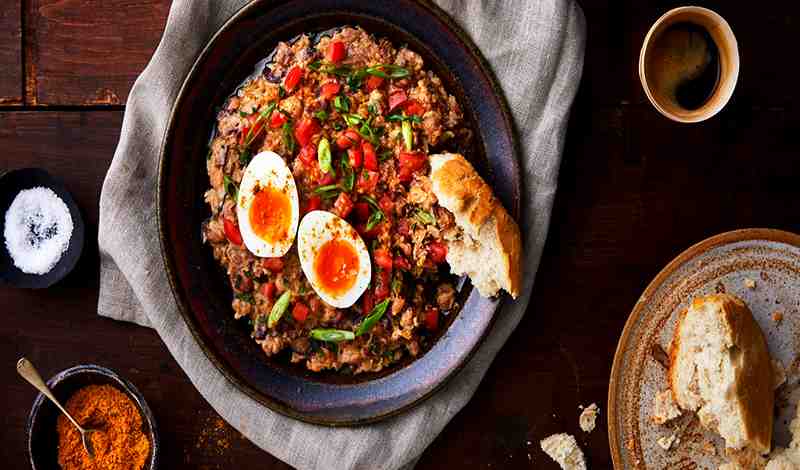The Ethiopian ful recipe is a very popular dish in Ethiopian cuisine. Vegetable stews are the staple in the cuisine, like vegetables with berbere sauce or beef and vegetables with misir wot. The ful is a dish of red lentils, so it is a straightforward recipe.

The Ethiopian ful recipe is cooked in water and has many spices to give it flavor. Before cooking, the ingredients are first sautéed before adding water and then simmered for about 20 minutes to half an hour until it turns into a thick liquid.
This recipe is very simple to follow, and you will be delighted with the results.
How To Make Ethiopian Ful Recipe?
Ingredients:
- 1 cup red lentils
- 1 cup yellow split peas (chana dal)
- 2 tablespoons salt
- 2 cups water/water stock (or use chicken stock if you prefer to use)
- 1 1/2 teaspoons turmeric powder (Haldi)
- 1 teaspoon ginger, grated (or 2 tablespoon ginger paste)
- 1 teaspoon cardamom seeds,
- Powdered or ground
- 1 garlic clove, chopped.
Method:
1. Heat a pan over medium heat and add:
2. Rinse lentils and yellow split peas and put them in the pan.
3. Add cardamom, turmeric, ginger, and garlic.
4. Pour half of the water/water stock into the pan, stirring to mix the spices well with the lentils and split peas. Close lid on the pan and lower heat to medium-low or low (not “stir”).
5. At this point, stir the sauce every few minutes to prevent the ingredients from sticking to the bottom of the pan.
6. Let it simmer for about 20 minutes or until it becomes a thick stew.
7. Stir and add more water/water stock (or chicken stock) if preferred
8. Add salt to taste and serve hot with injera with lots of butter, as you would eat berbere and misir wot dish.
Nutrition Facts Of Ethiopian Ful Recipe
Calories: 100
Carbohydrates: 18 g
Fiber: 5 g
Fat: 1g
Saturated Fatty Acids: 0.2 g
Monounsaturated Fatty Acids: 1.1 g
Polyunsaturated Fatty Acids: 0.6 g
Omega-3
fatty acids: 0
Best 10 Health Benefits Of Ethiopian Ful Recipe
1. Hearty Breakfasts
Ful is a common breakfast dish in Ethiopia and an excellent source of iron. It is also a good source of dietary fiber, which supports a healthy digestive system, heart, and colon health.
2. Heart Health
Red lentils are low in saturated fat and sodium and rich in folate. They contain some phytochemicals that may help lower cholesterol levels and heart-healthy soluble fiber that may help lower blood cholesterol levels naturally.
Ful is a good source of potassium, which helps maintain normal blood pressure.
3. Eye Health
Ful is a good source of lutein and zeaxanthin, antioxidants that support eye health. Lutein and zeaxanthin help maintain eye clarity by reducing the risk of age-related macular degeneration (AMD) and cataracts (colloquially known as “clouded” or “foggy” eyes). You can also use it to make injera (Injera recipe).
4. Tooth Health
Ful has some special carbohydrates called oligofructose, which have been shown to have the ability to help prevent tooth decay. It also contains vitamin B6 and potassium, both known for their role in tooth health.
5. Digestive Health
The pectin fiber in lentils is high in fiber that can help reduce the risk of colon cancer and divert food waste into the stool instead of leaving it in the body where bacteria can feed on it and cause problems. Folate, a low B vitamin in the western diet, may help reduce the risk of colon cancer. 5. Digestive Health [INSTRUCTION]
Pectin is a soluble fiber found in legumes and fruits that have been shown to have an anti-cancer effect by increasing short fecal chain fatty acids (SCFAs), which are essential for overall digestive health.
6. Diabetes
Red lentils form a complex with boron. B vitamins, such as folate and vitamin B6, are well known for their role in blood sugar regulation. Less understood is the role of other elements of the diet, such as magnesium and zinc, which may play a secondary role in diabetes management by helping to regulate blood sugar levels.
A diet high in soluble fiber – especially pectin – has been associated with a lower risk of type 2 diabetes.
7. Heart Health
Red lentils are a good source of heart-healthy soluble fiber. Soluble fiber helps lower body weight by slowing the stomach emptying, which may reduce appetite. Soluble fibers also help form a protective barrier over the intestines, reducing exposure to chemicals and bacteria in the stool that may cause disease.
The phytochemicals in red lentils have been shown to reduce inflammation, lower blood pressure and improve heart function.
8. Energy
Ful is an excellent source of iron energy. Iron is a component of hemoglobin, the oxygen-transporting protein in the blood.
9. Energy
In addition to boosting your energy level in the short term, a diet that encourages healthy iron levels in the body can also help boost you to your peak performance for many hours each day.
10. Immune Health
A few fresh red chilies can be added to the lentils and spice mix. This will add some heat to the dish. Still, it also provides phytochemicals that have been shown to have an anti-cancer effect by increasing short fecal chain fatty acids (SCFAs), which are important for overall digestive health.
Conclusion
The Ethiopian Ful recipe is one of the best vegetarian dishes and a good source of various nutrients. This recipe is not only for vegetarians, but it can also be used by non-vegetarians who want to try something a little different.
The Ethiopian recipes are healthy and tasty, so I recommend trying them out from this site.
I do hope you enjoyed this post. Until next time, may all be beautiful and delicious.